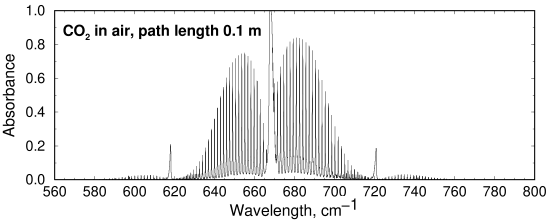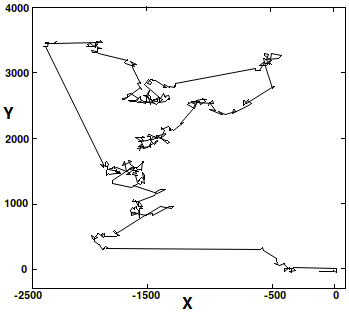 t is impossible, even in principle, for any model to prove that
something exists or that a theory is true. At most, it can prove
that a theory is wrong. In this article, I'll explain why that is so.
t is impossible, even in principle, for any model to prove that
something exists or that a theory is true. At most, it can prove
that a theory is wrong. In this article, I'll explain why that is so.
1. There are two variables: temperature and CO2.
2. Both are increasing. Let's assume both were measured accurately
and fairly (this is disputed, but let's grant the assumption).
3. The only connection between them is the theory, which we call
the CO2 theory. The theory is incorporated in a
computer model.
4. If a model gives the correct answer, it is not evidence that the
proposed mechanism is correct. It would only be consistent with it.
If it doesn't, it is unequivocal proof that the theory is incorrect.
5. The model does not give the correct answer, because it requires
“tuning” before it provides it.
6. Therefore, the model has given us information. We know the CO2
theory is incorrect.
7. This doesn't mean climate is or isn't “changing” or whether
“global warming” is true or false. It simply means we don't
know. It could be CFCs, for instance, or something else.
Let's pick some theory, oh I don't know, let's say global warming. This month, Los Angeles was hit by large-scale fires which some people claimed were caused, or maybe made worse, by global warming.
There are many things besides CO2, including CFCs and natural cycles, that correlate with warming. The primary purpose of the models was to test a hypothetical mechanism: that it was due to CO2. It's essential to prove cause and effect. If not, no matter how much warmer things get, all you have is a correlation. As will be shown below, the best anyone can do is to say the models are consistent with the theory. Because they did not predict the correct outcome, they failed. They succeeded only in confirming that our understanding of climate is still inadequate to make accurate predictions.
That's good news if you're the modeler because it gives you useful information. It's not so good for everyone else if an incorrect hypothesis is accepted. If warming should turn out to be a real problem, assigning the wrong cause could prevent us from finding a solution.
There are now thousands of papers claiming that global warming is causing everything from male infertility to neurological disorders to diarrhea to ADHD and even anthrax. One paper predicts that global warming will cause more deaths than Covid. (‘climate change’ is not used here because it's not a meaningful term.) Another predicts a billion human deaths of “mainly poor humans” by “mainly richer humans” and debates whether to call it murder or manslaughter. That's not to mention the claims that global warming exacerbates every fire and every hurricane and causes every cold day, every hot day, and every snowstorm. The scientific papers all say the same thing: there's “evidence” for it. But the missing link is causation. If the only “evidence” is a computer model, the papers are wrong: a computer model is not, and can never be, evidence, even if it's done correctly.
Thermal radiation
The basic theory of global warming is that visible light, UV, and near-infrared radiation coming from the sun are absorbed by the ground, then re-emitted as thermal infrared radiation, both during the day and at night. If re-radiation is blocked, the temperature rises to rebalance the incoming and outgoing energy, which must be equal.

Fig 1 Global warming has harmful effects on plants, causing widespread ice damage due to the freezing cold
You can think of infrared radiation as being in two types. There's near-infrared, which makes up about half of the radiation we get from the Sun; and thermal infrared, which is longer wavelengths, which we feel as heat. About half of the radiation we receive from the Sun is in the visible and half is near-infrared, or near-IR. There is also a much smaller amount of ultraviolet and thermal infrared. When visible, UV, or near-IR gets absorbed on your face or the ground it turns into heat, which can then be re-radiated. So, if there are gases that absorb radiation, you might think: Aha! Those gases get warmer, so the earth stays warmer. Unfortunately, that's not how it works. There are many factors that screw up this simple theory.
[This, incidentally, is why people hug each other. Hugging is a way for humans to reduce their energy output by stealing thermal energy from somebody else.]
You can see the different types of infrared radiation yourself. Snow doesn't absorb visible or near-IR light, but it strongly absorbs thermal infrared. On a sunny day, the visible and near-IR light are either reflected or transmitted, which means they pass right through the snow and get absorbed by the ground. At that point it's re-emitted as thermal IR. This is why the snow underneath is warmer than the snow on the surface and why it always melts from below rather than from the top.
Of course, top snow can also sublime and it can do other things, but the analogy to global warming is still valid. The question is not whether it can occur, but its relative importance compared to other factors. It's not all or nothing. The law of the excluded middle doesn't apply to science.
Absorption vs scattering
Absorption is logarithmically dependent on concentration, so each time CO2 doubles it theoretically raises the temperature by the same amount. Its main effect is to shorten the free path length of IR photons, which is the distance a photon travels after it's emitted before it gets scattered or absorbed.

Fig. 2 High resolution absorbance spectrum of carbon dioxide in air. The wings on both sides are vibration modes (Source: Hitran)
Physicists tell us that absorption and scattering are physically the same. The only difference is what happens to the energy after it gets absorbed. In scattering, the photon is emitted at a wavelength close to the original wavelength, called a transition line. In absorption, the photon is usually converted to mechanical vibration, where the molecules transfer their energy to each other by colliding with each other. There is always thermal energy getting emitted and re-absorbed. When there's a temperature gradient, this causes radiative or conductive energy transfer from the warmer molecule to the colder one.
People sometimes think that light absorption and emission occur in wide bands. This is not so: in gases, photons are emitted in very narrow bands (Fig. 2). The bands are slightly wider at the Earth's surface due to pressure broadening. Older spectrometers didn't have the resolution needed to show the bands accurately.
This has important consequences for a photon's path length. Fig. 3 shows the path a photon takes during scattering. When it scatters, its wavelength can be anywhere within the narrow emission line. This is called CFR or complete frequency redistribution. If it stays near the center of the line, it's quickly reabsorbed by another molecule. If it happens to be near the edge of the line, its path length can be 10,000 times greater. So the path doesn't resemble a random walk, but contains a mixture of short and long jumps. This is called Lévy flight.

Fig. 3 Photon scattering with CFR and Lévy flight. A photon in a gas doesn't follow a random walk path, but a complicated path with short and long jumps as it gets absorbed and re-emitted by scattering (Redrawn from [2], p. 16)
Entire books have been written on this interesting subject, which is called radiative transfer. They're stuffed with math formulas and technical details. If you're interested, I recommend Fundamentals of Atmospheric Radiation: An Introduction With 400 Problems by Craig F. Bohren and Eugene E. Clothiaux.[1] Believe it or not, this book is highly entertaining—and not just because of the 400 math problems!
At the current levels of 0.04%, absorption by CO2 is fully saturated, which means in simple terms that the mean path length of a photon could actually be a bit longer because it has to go farther before it can find a molecule that can absorb it. It also means we're way in the horizontal phase of the logarithmic curve, which means we've got as much warming from CO2 as we're ever going to get. Climate alarmists know this as well. This is why they've started nattering about methane and CFCs. They'll never admit that to the politicians because it would destroy their credibility to say they were wrong about CO2 and it was methane all along.
If you think warming is a problem, you will have painted your roof white instead of black to reflect the visible and UV light back to space. Didn't do it? That means at some level, the theory didn't convince even you.
Computer models
Given this complexity, you might think a computer model could suss it all out and tell us if there's a problem or not. Unfortunately, this is not true. A computer model can tell you if your theory is false, but it can never tell you if something is true. It certainly can't tell you whether something exists.
A computer model takes all the relationships in your theory, multiplies them by their relative importance, and spits out the answer. If the answer disagrees with measurements, it proves your theory is wrong. Period. If it agrees with measurements, it only means it's consistent with them, but that could just be a coincidence.
PK/PD models
To see this, let's look at drug testing. There are well understood formulas called PK/PD (pharmacokinetic / pharmacodynamic) models that tell you what should happen when you give a patient a drug. The concentration goes up in a certain characteristic way, then gradually declines over time. They're mostly exponential curves, but can also be saturable curves, which have a distinctly different shape. Can you decide the right dose for a patient based on a PK/PD simulation?
If you did, you'd get thrown in prison because it would be medical malpractice. You have to do animal experiments, then Phase 1 and 2 drug trials with volunteers to see if the theory predicts what actually happens. Pharmaceutical companies do clinical trials not because they're fun but because the government forces them to, and they're very expensive. And sometimes they fudge the statistics.
It often happens that the model gives the wrong answer. This is the only time you learn anything, namely that you don't understand everything that's going on. We once gave a patient a drug once a week and collected blood samples to see if we could predict the response. The model predicted the first twenty-four hours perfectly. Then the patient's cells adapted to the drug, and the model zigged and the patient zagged.
After that something even more unexpected happened. The resting level started increasing, which meant the drug was stuck in some compartment somewhere and being released very slowly. For reasons that have to do with the biochemistry of the target, this meant that the drug would quickly become useless; if you jacked up the dose, all you'd see are more side effects, some of which were so bad that some of our technicians refused to inject our mice with it.
That was an important discovery. The model conflicted with the theory, which meant that there was something new to discover. If we had “tuned” the model to account for it, we would never have discovered the truth. The company wasn't interested because it conflicted with what they wanted the drug to do, so they just ignored the result. No doubt they would have approved of some tuning.
Molecular docking models
Molecular docking models are sometimes used to predict the binding affinity of a drug for its target. I've done dozens of these, and they're useful for eliminating candidates that don't bind to your target. But if the model says it will bind with high affinity, it means little: standard scientific procedure is to then synthesize the drug and measure its actual affinity. No matter how expensive the software may be, the model can never be trusted. It has to be verified empirically before you spend ten cents on it.
That's exactly what is happening with those climate models. They predict the wrong result for the current state—this is a well known problem—and the models give the wrong result for the historical data. So they're “tuned” so they give the correct result for historical data. In any other field, this would get you fired because it is a scientifically invalid approach. The model proved that your theory was wrong, and so you changed the parameters to make the model give the answer you wanted.
Why is this invalid? That correction factor, or fudge factor, or whatever you want to call it, has no theoretical or experimental basis. Your model is no longer a model, but a program that gives the correct answer because you told it the correct answer and tweaked it until it gave it to you.
This is obviously cheating, but it's also a fundamental misunderstanding of the purpose of a model, which is to test your theory and see if the result matches what you observed. The goal isn't to have a computer model; the goal is to see if your theory is correct. If it doesn't match, your theory is wrong, period. If you tweak the model to give it the desired result, you learn nothing at all.
Predictions
Even if a computer model is on shaky ground, it could have some value if it generates predictions that are subsequently verified. Unfortunately, most of the changes, including changes in weather patterns, rising sea levels, ecological changes and tropical diseases, are consequences of temperature alone and thus say nothing about the theory. Other changes such as ocean acidification are related to CO2, not temperature. Thus, even if they occurred, they say nothing about the CO2 hypothesis, which is that there is a causal connection between CO2 and temperature.
Empirical testing
Is it possible to do an empirical test? Sure! This is called an interventionist experiment. You might, for instance, stop all use of so-called fossil fuels for a century or so and see if the temperature goes down. That would give you one data point. Then increase it and see if it goes back up. Repeat the cycle five or ten times, and it might become statistically significant.
There are obvious problems with this. It would take a long time, and it would be very expensive. People would cheat, as they do with the ozone hole. A year ago, the ozone hole was the biggest ever seen. Five of the previous eight years had seen record ozone holes. This year, it's smaller again. Nobody knows why, but the media are ignoring that and praising the 1987 Montreal Protocol as a glorious success.
The question is not whether it's possible for CO2 to cause warming; the question is whether it's a trivial amount as some say or a crisis as others say. Forget about invoking the precautionary principle. You can use that to support any position or its opposite. The fact is, you can't expect anybody to believe anything unless you have evidence for it, and you don't get evidence from a computer. Not only is the science not “settled”; as far as the CO2 hypothesis is concerned, there's no science there at all.
[1] Fundamentals of Atmospheric Radiation by Craig F. Bohren and Eugene E. Clothiaux
jan 18 2025, 4:06 am. summary box added jan 23
